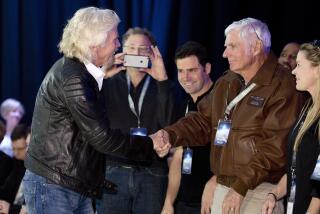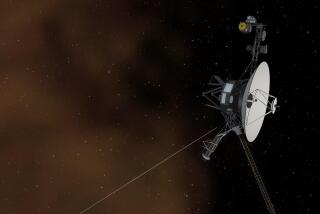Voyager Navigates Storms’ Edges for Side-Wind Boost
MOJAVE — Pilot Dick Rutan threaded the Voyager through two powerful tropical storms in the western Pacific on Tuesday, using side winds to whip the experimental aircraft Voyager along but managing to stay clear of violent winds that could have proved “devastating,” Voyager officials reported.
But Rutan was described as “moderately fatigued” after plunging through the potentially treacherous storms, and he got a friendly lecture from his doctor for not giving his co-pilot enough time in the driver’s seat.
“Dick doesn’t pay attention to what I say,” flight surgeon George Jutila told reporters at Voyager headquarters at the Mojave Airport. “There’s not a darn thing I can do except plead.”
Jutila said he expected Rutan to begin trading off more regularly with Jeana Yeager, who so far has spent most of the first three days in the tiny bunk aboard the Voyager as the two pilots try to become the first to fly nonstop around the world without refueling.
Fatigue a Critical Factor
As the projected 10-day flight progresses, fatigue increasingly looms as a critical factor for Rutan, 48, a former Air Force fighter pilot, and Yeager, 34. Both were exhausted after completing a 111-hour, record-breaking flight in the Voyager last July. During that flight, it took 2 1/2 days for him to settle into a comfortable routine, Jutila said.
The Voyager took off from Edwards Air Force Base at 8 a.m. Sunday, and Jutila said Tuesday that he expected Rutan and Yeager to “get into a rest-work cycle” before the day was over.
One reason for the fatigue is that the plane has been forced to keep both engines running longer than expected because of the heavy fuel load, thus making the cockpit excessively noisy.
“Fatigue is partially noise-generated,” Jutila said.
The Voyager is designed so that it can be flown with the rear engine only, thus increasing its range. But both engines are required for takeoff and until the plane burns enough fuel to lighten the load sufficiently to go to a single engine. Initially, that point was expected to be Monday night. But when Rutan shut down the forward engine the plane began losing altitude. And he had to restart it after about eight minutes, according to Voyager spokesman Peter Riva.
Rutan was expected to be able to shut it down for good late Tuesday.
2 Sleep Periods
During the first 48 hours, Rutan had only two sleep periods of three hours each, although he remained in the pilot’s seat for the first nap while Yeager monitored the aircraft, which was on automatic pilot.
Later, he slipped into the bunk for another three-hour nap. Although Jutila described Rutan as fatigued, he said both pilots were in good spirits and he expected them to settle down to a more relaxing routine.
That prediction came shortly after the Voyager darted between two violent tropical storms that packed winds of more than 80 m.p.h. and then rode the tail winds spun off by those storms to pick up speed.
“We just shot the curl and dodged the bullet,” meteorologist Len Snellman said.
“Dick is such a great pilot” that Voyager officials “wanted him to get as close to the storms as possible,” thus turning the weather to his advantage, he said.
Voyager got as close as 350 miles from the center of Tropical Storm Marge, Snellman said.
“We got through the tough part, Mom,” Snellman told Rutan’s mother, Irene, after the Voyager passed the test.
Later Tuesday, the Voyager ran into “some more turbulence that was pretty worrisome,” spokeswoman Wanda Wolf said. She said that encounter indicated that the rest of the flight will not all be clear sailing.
Flying at speeds up to 145 m.p.h. at an altitude of around 7,000 feet, the Voyager sped toward the Philippines and was to pass over that island nation late Tuesday. The plane was expected to pass just north of Malaysia by around 8 a.m. today.
The flight should then be fairly smooth across the Indian Ocean, Snellman said, although some local storms may force the plane to deviate from its course.
But “Africa is a darn problem,” Snellman added.
If the Voyager passes over Africa during the day, for instance, strong currents from the hot deserts below could cause considerable turbulence, he said.
That is the greatest weather concern now known for the rest of the flight, although other patterns could develop before the plane returns to Edwards Air Force Base near here. The Voyager is expected to complete its flight on Christmas Eve.
More to Read
Sign up for Essential California
The most important California stories and recommendations in your inbox every morning.
You may occasionally receive promotional content from the Los Angeles Times.










